
If there is a position in football that has seen the most evolution, then it is goalkeeping. From just saving, catching and kicking the ball a few decades back, the goalkeepers of today pass, distribute, sweep up and intercept the ball. Instead of being just a safe pair of hands, nowadays goalkeepers are needed to have a skillful pair of legs too.
It is almost like having an extra support in outfield. The two men who largely influenced this change, Johan Cruyff and Pep Guardiola, implemented this revolution during their heady days in the Camp Nou dugout. The latter, of course, was inspired by the former.
FC Barcelona have seen quite a few world-class shot-stoppers don the Blaugrana colours. Ricardo Zamora, Antoni Ramallets, Salvador Sadurni, Andoni Zubizarreta, Victor Valdes and now Marc Andre ter Stegen have all manned the posts with incredible skill and confidence. But, only two of them can be used as examples for the way the position has evolved in recent decades: Victor Valdes and Marc-André ter Stegen. Ter Stegen is, of course, currently plying his trade for the Catalan side.
The German Wall of Barça, Marc-André ter Stegen, is fondly called as MAtS. From getting castigated for letting in goals comically and doing howlers when guarding the posts, to being considered as the possibly the current best shot-stopper in Germany and one of the best in the world, Marc-Andre ter Stegen has indeed come a long way. He has been one of the best players for his club for quite some time. Going by his stellar form, it seems actually strange when he is on the bench during national duty.
The evolution of ter Stegen
Signed from Borussia Monchengladbach at a paltry fee of €12 million, Barcelona must be thanking the stars out there that they got him so early and cheaply. With quick reflexes, incredible decision making and supreme shot-stopping abilities during one-on-one situations, ter Stegen has established himself among the elite pantheon of top-class goalkeepers.
His ball-playing abilities completely suit Barça's playing style by allowing them to play out the ball from the back, and his excellent ball-distribution skills aid the club in starting swift attacks and breaking the first line of opponent press.
Marc-Andre ter Stegen dominates the penalty area. His quick speed when rushing off his line, and his ability to anticipate the onrushing opponent attackers, have rescued Barcelona countless times with the team maintaining a very high line of defence.
Now, he is one of the trusty doyens of the Barça dressing room and a leader on the pitch who is always committed and passionate about his team. Humble, hard-working and respectful, he shows all the qualities of a typical Barça player. The fans and experts alike, consider Marc-Andre ter Stegen as the only player apart from Messi, who is above any criticism.
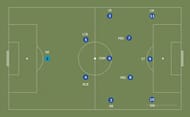
Now let us see what Marc-André ter Stegen actually does aside from making incredible single and double saves for his team. As ter Stegen’s position depends on the nature of play we will split our analysis accordingly. The general team setup is given in Figure 1 above and the Barcelona players are denoted by the blue icons with the ter Stegen in light blue.
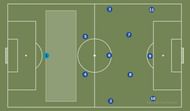
Advanced position
Before Cruyff's time, a goalkeeper's position tended to be, as you expect, near the goal line. This meant it was very difficult for the goalkeeper to intervene in case the opponent team had managed to get the ball in the highlighted area. Cryuff and Guardiola's philosophy mandated the goalkeeper to stay in a position much nearer to the defensive line when his team is on the offensive.
As you can see in Figure 2, ter Stegen places himself just outside the 18-yard box. He has two responsibilities in this situation. He ensures that the team always has the safe option to pass to keep the game going and more importantly, to defend the large space behind the central defenders (highlighted in Figure 2). The area outlined in the figure is a result of the visible high defensive line maintained by Barça and that is where the danger lies.
When Barcelona is on the attack, there is a real risk of losing the ball to the opponents. In such a situation, the opposition try to take advantage by getting the ball into the highlighted area in a quick transition from defence to attack so that their forwards can have a straight and clear line to the goal.
Ter Stegen, by virtue of placing himself in an advanced position, ensures that such balls are swept up by him, thereby neutralising any transitions where the ball gets behind the central defenders.
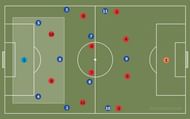
Strength in numbers
When Barcelona have the ball and the opposition are pressing, Marc-Andre ter Stegen's position depends on the play in order to create the first overload. Overload simply means having more players of your own team in a particular area than the opponents i.e. having superiority in numbers.
When the opponent is pressing Barcelona defenders in their own half, they find it very difficult to move the ball out. This particular situation highlights Ter Stegen's proficiency with the feet and his ball distribution.
Ter Stegen's primary responsibility is to be a part of his team's buildup while helping to counter the opponent press by generating a passing lane or a lofted ball to create the first overload. So, he has to move constantly across the face of the goal in relation to the ball.
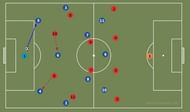
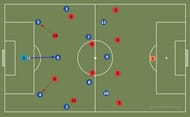
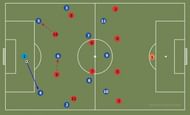
If you look at Figure 3, the highlighted box shows a clear four-versus-two situation in the final third. As Barcelona's tendency to build up from the back is well known, the opposition managers instruct their forwards to cover the Barcelona's central defenders and pivot (CDM) to try to stop Barça from moving forward.
But, Marc-Andre ter Stegen overcomes this using the passing lane towards the unmarked central defender or the defensive midfielder who has dropped deep to relieve the pressure at the back as shown in Figures 4 (1),4(2) and 4(3).
In case ter Stegen himself comes directly under pressure, all he does is simply pass the ball to an unmarked teammate who can then move forward and start an attack. As the defensive midfielder drops deep when the centre-backs are under pressure, an opposing midfielder or a forward might move to mark him as well (Figure 5).
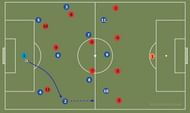
The opponent team’s structure will be such that one of the Barcelona full-backs won’t be marked (Figure 5). So, ter Stegen simply lofts the ball to that full-back who then makes a driving run forward to create an overload further up the pitch.
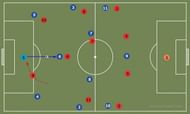
Good with his feet
But things can get a bit complicated when the central defensive midfielder is also under pressure. One of the pressing forwards might make an arching movement that makes it difficult for ter Stegen to make a pass to the centre-back while the other centre-back and the two full-backs are also marked closely, effectively increasing the pressure on the Barcelona defence (Figure 6).
It is here the importance of a ball-playing goalkeeper like ter Stegen can be seen because he is going to be the first overload, that is, he is going to be that one extra man who would give the team the advantage to counter the opposition press.
When the pivot is being marked and at the same time one of the forwards jumps ter Stegen, then a solution makes itself available. The opponent forward moves from marking one of the Barcelona centre-backs to press ter Stegen thereby freeing the said centre-back.
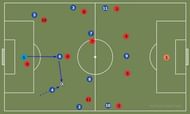
Simultaneously, the rest of the Barcelona outfield players try to make the pitch as big as possible i.e. they move away from each other to create space for possible movements to counter the opponent press.
Ter Stegen always tries to find the unmarked man near him. In the situation where he is being jumped by the opponent forward, all his team members near him are being marked (Figure 6). So, ter Stegen will decide to go for the next best option.
He finds the defensive midfielder who has dropped deep and has his back away from the goal. Ter Stegen has to make an accurate pass to the midfielder (Figure 6) who in turn makes a quick pass into the open area expecting the free centre-back to get the ball and move into space (Figure 7).
Now, the centre-back moves forward with the ball to create the next overload further along the pitch. This results in an effective counter to opponent pressing and also the start of an attack from the back.
This transition from being under pressure to attacking greatly depends on the accuracy and precision of the first pass from the goalkeeper. That is why the ball playing ability of ter Stegen and also his decision making under pressure are so crucial to his team’s play.
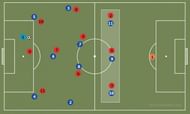
The opponent team might also resort to a strategy that reduces passing options for the goalkeeper by maintaining a very deep and aggressive pressing along with man-marking. This is the most complicated situation a goalkeeper can be in while the ball is at his feet.
In this case, the opponent players will try to push the goalkeeper into a corner and reduce the directions of passing. Such a tactic greatly reduces the passing options for ter Stegen. The least risky pass option is a pass to the free full-back but the opponent forward will position himself in such a way that the goalkeeper won’t be able to utilize him.
This, inevitably leads to a three-versus-three situation in the front. In such a situation, the goalkeeper’s decision greatly depends on his own ability and accuracy. If the goalkeeper’s long passes are not accurate enough and his team’s centre-backs or midfielders are press resistant, he might go for the short passing options and hope his team can play out the ball to the opponent's half. Ter Stegen, who has high ball distributing range and accuracy, usually goes for the long passes.
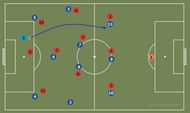
He provides a vaulted pass directly and precisely to the Barcelona forwards who are good with the ball and are on a three-vs-three situation in the front. Then, it is just a matter of individual skill or good coordination between the forwards before a goalscoring opportunity is created.
Continuously following this strategy might also make the opponents to withdraw, thereby relieving the pressure on the Barça defence. In both cases; short and long passes; Marc-Andre ter Stegen has this ability of being aware of his teammates and the opponent players’ positions across the pitch and makes his decision accordingly.
A tweak
Finally, a new concept has emerged under the new manager Quique Setién. It is a result of a new rule change that has been introduced by FIFA from the 2019-20 season. This particular change concerns the way goal-kicks are taken. Previously, while taking a goal-kick, no players other than the goalkeeper can be present inside the penalty area and that included the teammates of the goalkeeper.
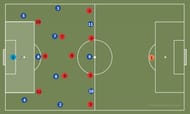
As you can see in Figure 10, the pressing team, during a goal-kick, forces the team trying to build up from the back deep into their own area by pressing aggressively.
This gave an unfair advantage to the pressing team during the goal-kicks. Now, this rule has been changed. The team taking the goal-kick can have players other than the goalkeeper inside the penalty box but, the opponent players cannot enter the area before the ball is in play. So, the team trying to play out from the back can have an easier time dealing with the high press during goal kicks.
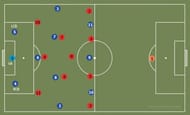
Barcelona has used this new rule to introduce a revolutionary tactic to counter the aggressive pressing during goal kicks. This was evident in their home game against Getafe in this season. Getafe this season has adopted a very aggressive and high-pressure pressing trying to push their opponents as deep in their half as possible.
During a goal-kick, the two Barça centre-backs positioned themselves a short distance from ter Stegen on either side of him. Remember, the opponent players must not enter the penalty area before the ball is in play. This effectively increased the distance between the players which created more space for the Blaugrana to play the ball in.
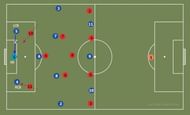
To counter the Getafe high press, ter Stegen unusually gave the ball to one of his team's centre-backs Samuel Umtiti to take the goal-kick. Umtiti then proceeded to play a short pass to ter Stegen. From Figure 12, we can see that there was a quite bit of a distance for the pressing forwards to cover if they decide to move towards the goalkeeper. By the time they cover that distance, ter Stegen can easily pass the ball to his team's wing-backs who are unmarked.
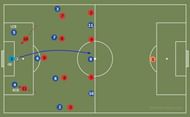
Or, if the wing-backs are being marked, ter Stegen executes a long vaulted pass to his team's forwards (as shown in Figure 13) who are on a three-versus-three situation in the front.
Another advantage presents itself to the goalkeeper due to this new rule change. One which ter Stegen has already used to produce two assists for himself. During a goal kick, the forwards cannot be offside. Combining this with the rule that no opponent players can be present inside the penalty area during a goal-kick, it is a huge advantage for ter Stegen who can make a direct pass to his team's forwards who will have a very easy way to the goal.
This is how Marc-Andre ter Stegen contributes to the strategy of the side apart from being the eponymous wall for his team.
